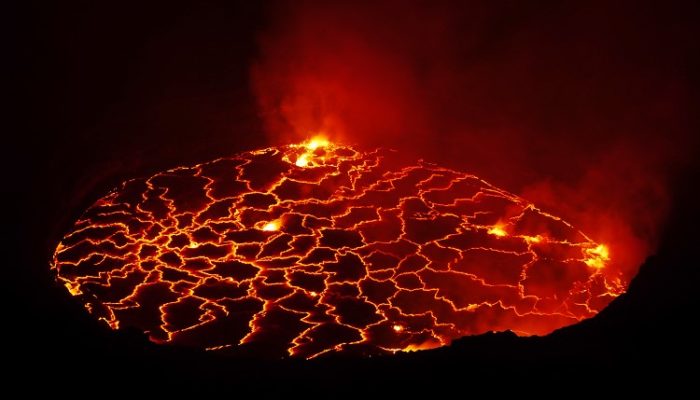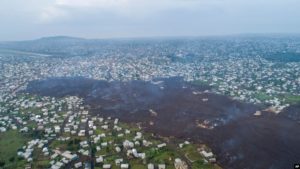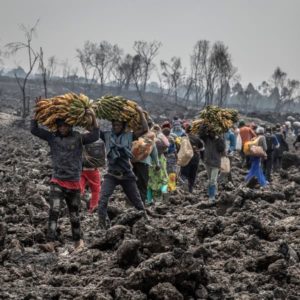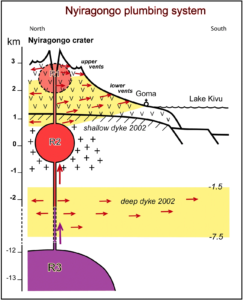
Since ancient times, the growth of populations has been strongly combined with the presence of volcanoes, due to their ability to provide nutrients to soils (and so to agriculture) and resource extraction. One great example is described in our blog post about Volcanoes and wine. However, living near a volcano has its (obvious) drawbacks, starting with lava flows (see the recent Cumbre Vieja eruption) and tsunamis of large submarine volcanoes affecting the surroundings (such as the Hunga Tonga eruption).
For sure, Mount Nyiragongo is another example of how the population can deal and live with an active volcano. Goma residents usually refer to Mount Nyiragongo as a cultural and spiritual icon where ‘gods’ live, while for many tourists visiting Goma, Mount Nyiragongo offers scenic beauty. In the morning hours, the residents of Goma could be seen gazing at and respecting Mount Nyiragongo. But in the morning of 22/05/2021, the ‘gods’ of Mount Nyiragongo got angry and fumed.

Mount Nyiragongo’s lava reaching the city of Goma during the eruption of May 2021 (from VOA News)
The Mount Nyiragongo volcano and its lava lake
Mount Nyiragongo is a strata-volcanic mountain formed by volcanic processes which are hardened with flowing lava and pyroclastic rocks. Considered Africa’s most active volcano (Tedesco et al., 2007), it is well known mainly for its persistent lava lake activity, and for a foiditic magma composition, producing extremely fluid lava flows (Tedesco et al., 2007). It is located on the western branch of the East African Rift System (EARS), inside the Vivunga National Park, which borders Rwanda and the Democratic Republic of Congo, ~13km north of Goma town. The main crater is about 2km wide with the largest lava lake in the world at the top.
Nyiragongo lava lake is the largest and most active in the world, and is the uppermost and exposed part of the volcanic plumbing system, displaying what is generally not visible at other open vent volcanoes (Valade et al., 2018). Recently, Barrière et al. (2022) obtained the first reliable picture and evolution in time of the lava lake between 2005 and 2021, combining satellite images and photogrammetry. They were able to notice how the lake is filled by pulsatory episodes, while the seismic activity turned out to be associated with deep magma intrusions and the largest lava lake drops.
Mount Nyiragongo cones consist of pyroclastic and lava flows that are low silica and alkali rich. They contain extrusive ultramafic rocks which are free of feldspars (Tedesco et al., 2007). In 1977, the fractures of the crater led the lava lake to drain in less than an hour, causing lava to flow faster than 60 km/h, killing ~600 people. In 2002, a new major eruption began, with the opening of a 13 km long fissure. The lava reached the town of Goma, covering 13% of its surface, and ~200 people died from carbon dioxide (Burgi et al., 2014).
The 22nd May 2021 eruption
Most recently, on 22nd May 2021, an eruption began, when lava flew up to Goma Airport and moved towards the center of Goma City. Thousands of residents left their homes as authorities warned of more eruptions, and electricity was cut off following them. A number of people lost their lives: the eruption resulted in over 50 casualties, caused by hot lava and inhalation of sulfur gasses, burns, and injuries. The tourism ecosystem was disrupted particularly along the Virunga National park, a UNESCO world heritage site and Africa’s most biodiverse protected area, famous for being home to the endangered mountain gorillas.
However, living with a volcano doesn’t necessarily mean dealing with large eruptions and seismic swarms (Antosia and Cahill, 2006). Indeed, the high degassing activity of Mount Nyiragongo can influence the chemistry of rainwater in the area (Cuoco et al., 2013), mainly at the summit crater. The predominant westward wind direction pushes the volcanic plumes into the area of rainwater collection for drinking purposes, causing natural contamination of the main drinking water supply in the west Nyiragongo villages.

Residents leaving their towns: nearly 416,000 people in DR Congo were displaced due to the volcanic eruption
Mount Nyiragongo possesses a great hazard potential to a larger population, particularly to nearby towns situated at the foot of the mountain. Research shows that it is very much an active volcano with the potential to erupt again and disrupt the lives of Goma City residents (Oregonstate.edu). Until recently, the volcano is actively monitored by a team of scientists from Goma Volcanic Observatory (GVO), together with the Nyamulagira volcano where seismic data and temperatures are recorded daily.
For sure, Mount Nyiragongo is still widely studied by geologists and respected by the residents.
REFERENCES
Tedesco, D., Vaselli, O., Papale, P., Carn, S. A., Voltaggio, M., Sawyer, G. M., … & Tassi, F. (2007). January 2002 volcano‐tectonic eruption of Nyiragongo volcano, Democratic Republic of Congo. Journal of Geophysical Research: Solid Earth, 112(B9).
Burgi, P-Y., T. H. Darrah, D. Tedesco, and W. K. Eymold. “Dynamics of the Mount Nyiragongo lava lake.” Journal of Geophysical Research: Solid Earth 119, no. 5 (2014): 4106-4122.
Pouclet, A., & Bram, K. (2021). Nyiragongo and Nyamuragira: a review of volcanic activity in the Kivu rift, western branch of the East African Rift System. Bulletin of Volcanology, 83(2), 1-35.
Valade, Sébastien, Maurizio Ripepe, Giovanni Giuffrida, Katcho Karume, and Dario Tedesco. “Dynamics of Mount Nyiragongo lava lake inferred from thermal imaging and infrasound array.” Earth and Planetary Science Letters 500 (2018): 192-204.
Barrière, J., d’Oreye, N., Smets, B., Oth, A., Delhaye, L., Subira, J., … & Kervyn, F. (2022). Intra-Crater Eruption Dynamics at Nyiragongo (DR Congo), 2002–2021. Journal of Geophysical Research: Solid Earth, 127(4), e2021JB023858.
Antosia, Robert E., and John D. Cahill. Handbook of bioterrorism and disaster medicine. New York, N.Y.: Springer, 2006
Cuoco, Emilio, Antonio Spagnuolo, Charles Balagizi, Stefano De Francesco, Franco Tassi, Orlando Vaselli, and Dario Tedesco. “Impact of volcanic emissions on rainwater chemistry: The case of Mt. Nyiragongo in the Virunga volcanic region (DRC).” Journal of Geochemical Exploration 125 (2013): 69-79.
Oregon State University: “Volcano Sounds.” http://volcano.oregonstate.edu/



Pingback: GeoLog | GeoTalk: meet Blaise Nyandwi, researcher in public perceptions of volcanic hazards!